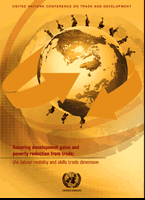
It is becoming increasingly clear that the issue of global labour movement and integration is a key topic at the interfaceof trade, development and globalization. In 2005 the global labour force numbered 2.8 billion, of which 2.25 billion wasdeveloping country labour force.
This paper attempts to provide a comprehensive picture of the impact on trade, development and poverty reduction brought about by global labour movement and integration. It attempts to answer the question as to how temporary labour mobility can be better managed so as to contribute to improving people´s livelihood and welfare prospects while at the same time moving closer to the achievement of internationally agreed development goals, in particular the United Nations Millennium Development Goals.
The paper looks at temporary labour mobility and skills trade as it relates to trade and development from the perspectives ofboth sending and receiving countries. It sets out the problem of labour mobility, the state of play in the global labourmarket, push-pull factors that cause labour mobility and succinctly, the seven inconsistencies of the labour movementconundrum. A detailed examination of the socio-economic costs and benefits to sending and receiving countries providesa balanced overview of the picture.
From the trade perspective the paper argues that progress in allowing temporary movement of labour by means of multilateral and regional or bilateral agreements is important to further good global governance, coherence and solidarity necessary for achieving Millennium Development Goals.
The paper concludes with several mutually beneficial policy recommendations which would ensure the sustained positive effects of migration on development.



